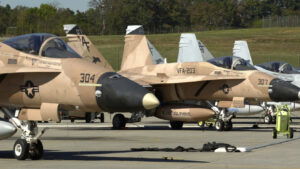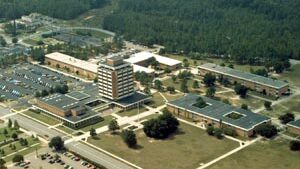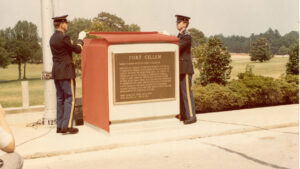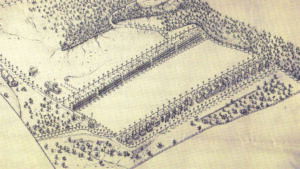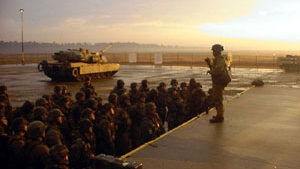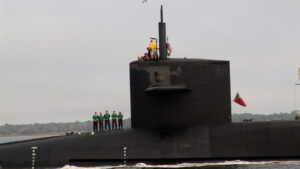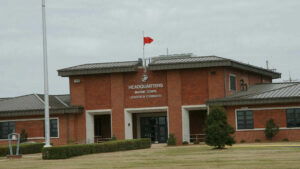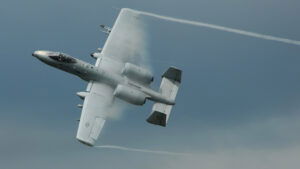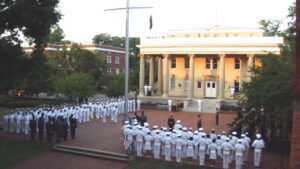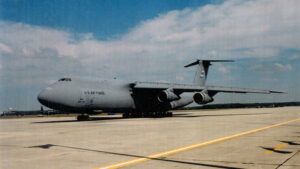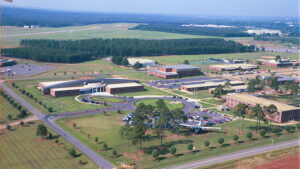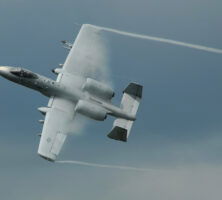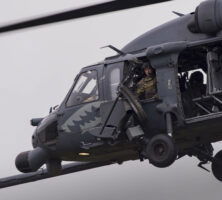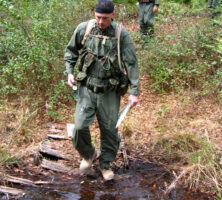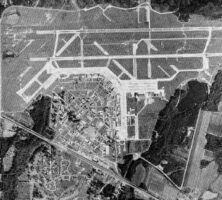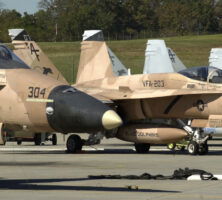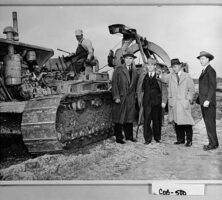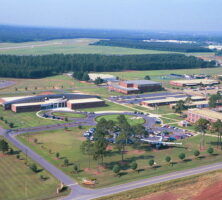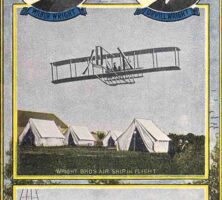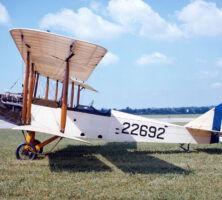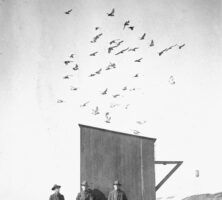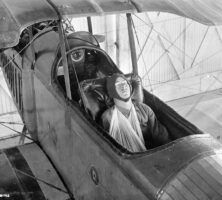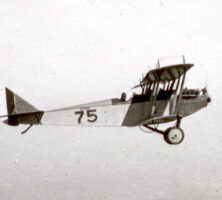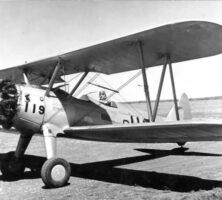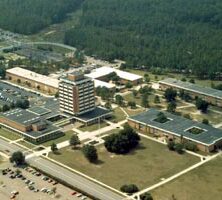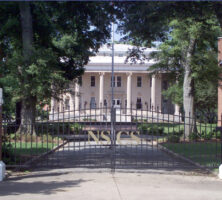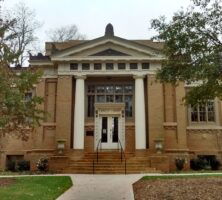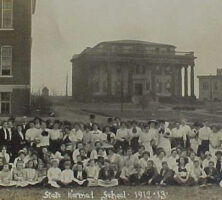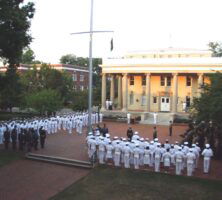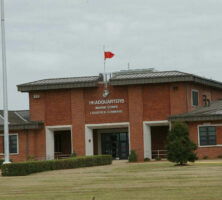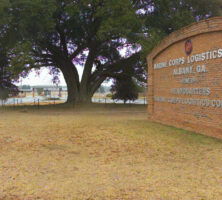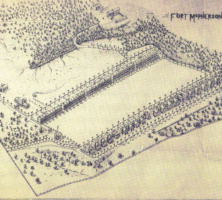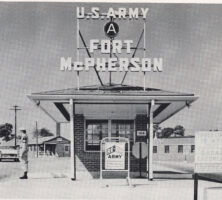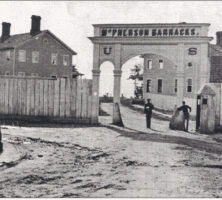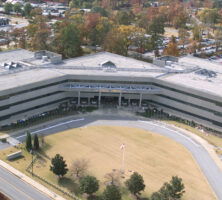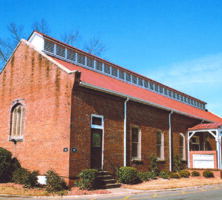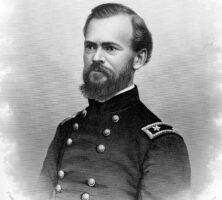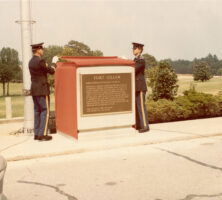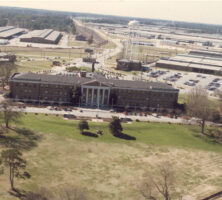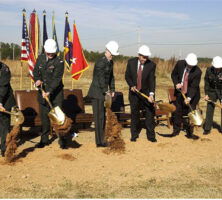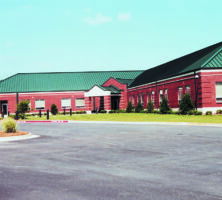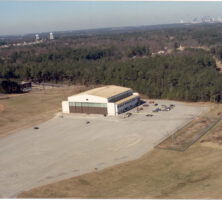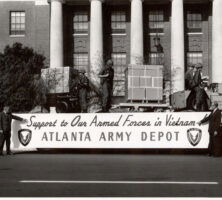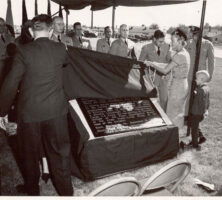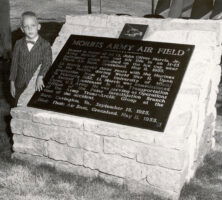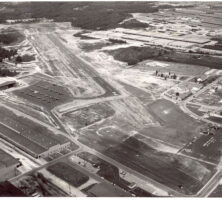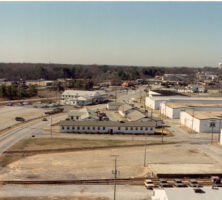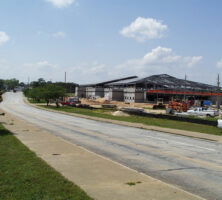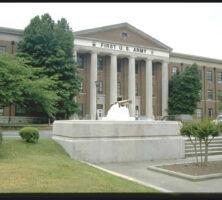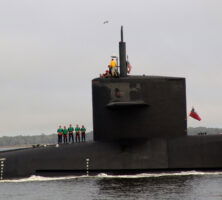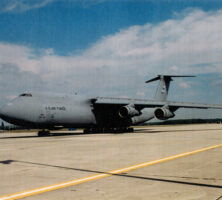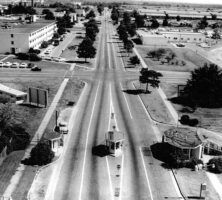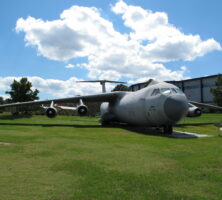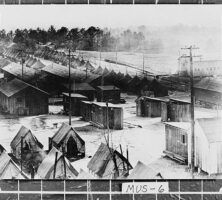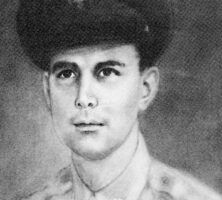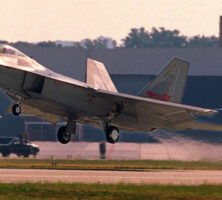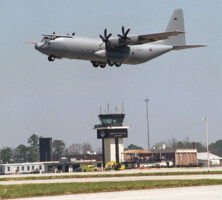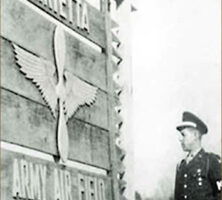The New Georgia Encyclopedia is supported by funding from A More Perfect Union, a special initiative of the National Endowment for the Humanities.
Moody Air Force Base in Lowndes County is home to the A-10 aircraft. The A-10C Thunderbolt II pictured here is equipped with satellite-guided precision weaponry and is used for the air force's search-and-rescue missions.
Courtesy of Moody Air Force Base. Photograph by Parker Gyokeres
The New Georgia Encyclopedia does not hold the copyright for this media resource and can neither grant nor deny permission to republish or reproduce the image online or in print. All requests for permission to publish or reproduce the resource must be submitted to the rights holder.
An HH-60G Pave Hawk helicopter hovers over a field at Moody Air Force Base in Lowndes County. The helicopters are used by the air force to conduct search-and-rescue missions in hostile environments, especially to recover downed aircrew or other isolated military members during war.
Image from U.S. Air Force
The New Georgia Encyclopedia does not hold the copyright for this media resource and can neither grant nor deny permission to republish or reproduce the image online or in print. All requests for permission to publish or reproduce the resource must be submitted to the rights holder.
Airmen from the 41st Rescue Squadron and the 347th Operations Support Squadron, based at Moody Air Force Base, participate in combat survival training in the Grand Bay Wildlife Management Area, near Moody.
Courtesy of Moody Air Force Base. Photograph by Eric Schloeffel
The New Georgia Encyclopedia does not hold the copyright for this media resource and can neither grant nor deny permission to republish or reproduce the image online or in print. All requests for permission to publish or reproduce the resource must be submitted to the rights holder.
Moody Air Force Base in Valdosta is home to the 23d Wing, which includes the 347th Rescue Group. More than 4,600 military and civilian personnel are assigned to the 12,000-acre base.
Courtesy of Beryl I. Diamond
The New Georgia Encyclopedia does not hold the copyright for this media resource and can neither grant nor deny permission to republish or reproduce the image online or in print. All requests for permission to publish or reproduce the resource must be submitted to the rights holder.
F-18 fighter jets wait on the flight line of the Naval Air Station at Dobbins Air Reserve Base in Marietta. The Hornets first arrived at the air station in the early 1990s, with Fighter Attack Squadron 203.
Courtesy of Atlanta Journal-Constitution.
The New Georgia Encyclopedia does not hold the copyright for this media resource and can neither grant nor deny permission to republish or reproduce the image online or in print. All requests for permission to publish or reproduce the resource must be submitted to the Atlanta Journal-Constitution.
In 1955 Congress appropriated more than $4 million to build a facility in Marietta that would allow for longer runways than those at Naval Air Station Atlanta in Chamblee. Construction was completed in 1959. Pictured, from left, are Eddie Richebacker, James V. Carmichael, L. M. "Rip" Blair, and George McMillan.
Courtesy of Georgia Archives, Vanishing Georgia, #
cob500.
The New Georgia Encyclopedia does not hold the copyright for this media resource and can neither grant nor deny permission to republish or reproduce the image online or in print. Requests for permission to publish or reproduce the resource should be submitted to the Georgia Archives.
Souther Field's concrete runways are visible in the upper left of this photograph. In the foreground is South Georgia Technical College, which now occupies the grassy field where Charles Lindbergh conducted his solo takeoff and landing as well as his many practice flights. Souther Field Road (formerly Souther Road) is visible at the bottom right and borders the college.
Courtesy of Jerry Stovall, South Georgia Technical College
The New Georgia Encyclopedia does not hold the copyright for this media resource and can neither grant nor deny permission to republish or reproduce the image online or in print. All requests for permission to publish or reproduce the resource must be submitted to the rights holder.
This postcard depicts the Wright brothers' Military Flyer, first flown in 1909. The development of this plane marks the beginning of U.S. military aviation. In World War I, the demands of battle dictated many uses for flying machines, including reconnaissance, bomb deployment, and the pursuit and attack of other planes.
The New Georgia Encyclopedia does not hold the copyright for this media resource and can neither grant nor deny permission to republish or reproduce the image online or in print. All requests for permission to publish or reproduce the resource must be submitted to the rights holder.
The Standard biplane was used for training by the U.S. Army. The first plane to take off and land at Souther Field, in 1917, was a Standard.
Image from U.S. Air Force
The New Georgia Encyclopedia does not hold the copyright for this media resource and can neither grant nor deny permission to republish or reproduce the image online or in print. All requests for permission to publish or reproduce the resource must be submitted to the rights holder.
Carrier pigeons and a pigeon house at Souther Field, in Sumter County, in 1918. Souther Field was constructed as a military flight-training facility, and the pigeons were used to transmit messages before the development of sophisticated communications systems.
Courtesy of Georgia Archives, Vanishing Georgia, #
sum041.
The New Georgia Encyclopedia does not hold the copyright for this media resource and can neither grant nor deny permission to republish or reproduce the image online or in print. Requests for permission to publish or reproduce the resource should be submitted to the Georgia Archives.
Pictured in 1918, a wounded soldier awaits transport in a hospital airplane at Souther Field in Sumter County. Souther Field, a military aviation training facility, is today known as Jimmy Carter Regional Airport.
Courtesy of Georgia Archives, Vanishing Georgia, #
sum034.
The New Georgia Encyclopedia does not hold the copyright for this media resource and can neither grant nor deny permission to republish or reproduce the image online or in print. Requests for permission to publish or reproduce the resource should be submitted to the Georgia Archives.
A JN-4 Jenny flies vertically as a "wing walker" jumps from the plane. The walker is wearing a parachute, which he will wait to deploy until he is very near the ground. Such aerial stunts, referred to as "barnstorming," were performed by famous pilot Charles Lindbergh when he was first learning to fly in 1922.
Image by George Johnson, Aviation Section, U.S. Army Signal Corps
The New Georgia Encyclopedia does not hold the copyright for this media resource and can neither grant nor deny permission to republish or reproduce the image online or in print. All requests for permission to publish or reproduce the resource must be submitted to the rights holder.
The Boeing Stearman PT-17 was the primary flight-training airplane of World War II. Built similarly to those flown at Souther Field, this PT-17 was photographed in Texas during World War II. At the controls sits an aviation cadet.
Courtesy of Scott Hedgland
The New Georgia Encyclopedia does not hold the copyright for this media resource and can neither grant nor deny permission to republish or reproduce the image online or in print. All requests for permission to publish or reproduce the resource must be submitted to the rights holder.
Fort Gordon, located southwest of Augusta, opened in December 1941, after the Japanese bombing of Pearl Harbor in Hawaii during World War II. The installation was named in honor of Confederate general John B. Gordon.
Courtesy of U.S. Army Signal Corps Museum
The New Georgia Encyclopedia does not hold the copyright for this media resource and can neither grant nor deny permission to republish or reproduce the image online or in print. All requests for permission to publish or reproduce the resource must be submitted to the rights holder.
The New Georgia Encyclopedia does not hold the copyright for this media resource and can neither grant nor deny permission to republish or reproduce the image online or in print. All requests for permission to publish or reproduce the resource must be submitted to the rights holder.
The New Georgia Encyclopedia does not hold the copyright for this media resource and can neither grant nor deny permission to republish or reproduce the image online or in print. All requests for permission to publish or reproduce the resource must be submitted to the rights holder.
The New Georgia Encyclopedia does not hold the copyright for this media resource and can neither grant nor deny permission to republish or reproduce the image online or in print. All requests for permission to publish or reproduce the resource must be submitted to the rights holder.
The New Georgia Encyclopedia does not hold the copyright for this media resource and can neither grant nor deny permission to republish or reproduce the image online or in print. All requests for permission to publish or reproduce the resource must be submitted to the rights holder.
The New Georgia Encyclopedia does not hold the copyright for this media resource and can neither grant nor deny permission to republish or reproduce the image online or in print. All requests for permission to publish or reproduce the resource must be submitted to the rights holder.
A unit commander addresses his soldiers in the early morning hours on Red Cloud Range, Fort Stewart, 2002.
Courtesy of United States Army
The New Georgia Encyclopedia does not hold the copyright for this media resource and can neither grant nor deny permission to republish or reproduce the image online or in print. All requests for permission to publish or reproduce the resource must be submitted to the rights holder.
The New Georgia Encyclopedia does not hold the copyright for this media resource and can neither grant nor deny permission to republish or reproduce the image online or in print. All requests for permission to publish or reproduce the resource must be submitted to the rights holder.
The New Georgia Encyclopedia does not hold the copyright for this media resource and can neither grant nor deny permission to republish or reproduce the image online or in print. All requests for permission to publish or reproduce the resource must be submitted to the rights holder.
The New Georgia Encyclopedia does not hold the copyright for this media resource and can neither grant nor deny permission to republish or reproduce the image online or in print. All requests for permission to publish or reproduce the resource must be submitted to the rights holder.
Women's Airforce Service Pilots (WASPs) at Liberty Field, Camp Stewart, circa 1944. WASPs flew planes towing antiaircraft targets out of Liberty Field during World War II.
Image from National Museum of the U.S. Air Force
The New Georgia Encyclopedia does not hold the copyright for this media resource and can neither grant nor deny permission to republish or reproduce the image online or in print. All requests for permission to publish or reproduce the resource must be submitted to the rights holder.
The New Georgia Encyclopedia does not hold the copyright for this media resource and can neither grant nor deny permission to republish or reproduce the image online or in print. All requests for permission to publish or reproduce the resource must be submitted to the rights holder.
The New Georgia Encyclopedia does not hold the copyright for this media resource and can neither grant nor deny permission to republish or reproduce the image online or in print. All requests for permission to publish or reproduce the resource must be submitted to the rights holder.
From 1954 until 2010, all active-duty supply corps officers in the U.S. Navy were trained at the Navy Supply Corps School in Athens. In 2010 the school relocated to Newport, Rhode Island, and in 2012 the UGA Health Sciences Campus opened on the Athens site.
Courtesy of the United States Navy
The New Georgia Encyclopedia does not hold the copyright for this media resource and can neither grant nor deny permission to republish or reproduce the image online or in print. All requests for permission to publish or reproduce the resource must be submitted to the rights holder.
Housed in a former Carnegie Library building (built circa 1910), the Navy Supply Corps Museum was located on the campus of the Navy Supply Corps School, which operated in Athens from 1954 until 2010.
Image from RFoxx
The New Georgia Encyclopedia does not hold the copyright for this media resource and can neither grant nor deny permission to republish or reproduce the image online or in print. All requests for permission to publish or reproduce the resource must be submitted to the rights holder.
Teachers at the State Normal School in Athens are pictured circa 1912. The U.S. Navy purchased the normal school site in 1953 and the following year opened the Navy Supply Corps School, which remained in Athens until 2010.
Courtesy of the United States Navy
The New Georgia Encyclopedia does not hold the copyright for this media resource and can neither grant nor deny permission to republish or reproduce the image online or in print. All requests for permission to publish or reproduce the resource must be submitted to the rights holder.
Officers in training stand in formation outside of Winnie Davis Hall on the campus of the Navy Supply Corps School, which was located in Athens from 1954 until 2010.
Courtesy of the United States Navy
The New Georgia Encyclopedia does not hold the copyright for this media resource and can neither grant nor deny permission to republish or reproduce the image online or in print. All requests for permission to publish or reproduce the resource must be submitted to the rights holder.
Headquarters of the Marine Corps Logistics Base, located in Dougherty County in southwest Georgia, approximately five miles southeast of Albany.
Photograph by Corporal Andrew Roufs
The New Georgia Encyclopedia does not hold the copyright for this media resource and can neither grant nor deny permission to republish or reproduce the image online or in print. All requests for permission to publish or reproduce the resource must be submitted to the rights holder.
The Dubber Oak, the tree upon which the base was aligned during construction, still stands near the Marine Corps Logistics Base main gate. The oak is named for Colonel "A" "E" Dubber, the officer who chose the Albany site and insisted on preserving wildlife and trees during its development.
Photograph by Lance Corporal Kevin Ridlon
The New Georgia Encyclopedia does not hold the copyright for this media resource and can neither grant nor deny permission to republish or reproduce the image online or in print. All requests for permission to publish or reproduce the resource must be submitted to the rights holder.
Early plan of Fort McPherson, which was located in southeast Atlanta from 1885 until 2011.
Courtesy of Fort McPherson
The New Georgia Encyclopedia does not hold the copyright for this media resource and can neither grant nor deny permission to republish or reproduce the image online or in print. All requests for permission to publish or reproduce the resource must be submitted to the rights holder.
The old Lee Street gate of Fort McPherson is pictured in 1960. The installation, which occupied nearly 500 acres in southeast Atlanta from 1885 to 2011, was one of the largest command centers in the U.S. military.
Courtesy of Fort McPherson
The New Georgia Encyclopedia does not hold the copyright for this media resource and can neither grant nor deny permission to republish or reproduce the image online or in print. All requests for permission to publish or reproduce the resource must be submitted to the rights holder.
Historical photograph of the entrance to the barracks at Fort McPherson, located in southeast Atlanta from 1885 until 2011.
Courtesy of the Army in Atlanta Museum
The New Georgia Encyclopedia does not hold the copyright for this media resource and can neither grant nor deny permission to republish or reproduce the image online or in print. All requests for permission to publish or reproduce the resource must be submitted to the rights holder.
The headquarters for U.S. Army Forces Command (FORSCOM), housed in a 356,000-square-foot complex covering five acres at Fort McPherson, was the workplace of some 2,000 military and civilian employees. The fort closed in 2011, and FORSCOM moved to Fort Bragg, North Carolina.
Courtesy of Garrison Public Affairs Office, Fort McPherson
The New Georgia Encyclopedia does not hold the copyright for this media resource and can neither grant nor deny permission to republish or reproduce the image online or in print. All requests for permission to publish or reproduce the resource must be submitted to the rights holder.
The chapel at Fort McPherson, an army command center located south of Atlanta from 1885 until 2011.
Courtesy of Garrison Public Affairs Office, Fort McPherson
The New Georgia Encyclopedia does not hold the copyright for this media resource and can neither grant nor deny permission to republish or reproduce the image online or in print. All requests for permission to publish or reproduce the resource must be submitted to the rights holder.
This engraving depicts Major General James McPherson, for whom Fort McPherson in southeast Atlanta was named. The Union general was killed in action during the Battle of Atlanta on July 22, 1864.
From The History of the State of Georgia, by I. W. Avery
The New Georgia Encyclopedia does not hold the copyright for this media resource and can neither grant nor deny permission to republish or reproduce the image online or in print. All requests for permission to publish or reproduce the resource must be submitted to the rights holder.
Two members of the U.S. Army Forces Command Color Guard unveil the plaque dedicating Fort Gillem, formerly the Atlanta Army Depot, during activation ceremonies held on June 28, 1974. The fort was named in honor of Lieutenant General Alvan C. Gillem Jr., former commander of the Third U.S. Army.
Courtesy of Garrison Public Affairs Office, Fort McPherson
The New Georgia Encyclopedia does not hold the copyright for this media resource and can neither grant nor deny permission to republish or reproduce the image online or in print. All requests for permission to publish or reproduce the resource must be submitted to the rights holder.
In 1995 the First U.S. Army was reorganized at Fort Gillem, in Forest Park. First Army headquarters, building 101, sat on a small hill above the sprawling base, which closed in 2011.
Courtesy of Garrison Public Affairs Office, Fort McPherson
The New Georgia Encyclopedia does not hold the copyright for this media resource and can neither grant nor deny permission to republish or reproduce the image online or in print. All requests for permission to publish or reproduce the resource must be submitted to the rights holder.
The groundbreaking for a new forensics laboratory at Fort Gillem was held on November 25, 2002. From left to right, Major General Donald J. Ryder; Colonel Harold E. Cooney; Lieutenant Colonel William S. Schaff Jr.; Larry Chelko, director of the laboratory; William A. Story, president of Beers Skanska, Inc.; and Colonel Roger A. Gerber.
Courtesy of Garrison Public Affairs Office, Fort McPherson
The New Georgia Encyclopedia does not hold the copyright for this media resource and can neither grant nor deny permission to republish or reproduce the image online or in print. All requests for permission to publish or reproduce the resource must be submitted to the rights holder.
This 28,000-square-foot building opened on January 13, 2000, to house the Military Entrance Processing Station at Fort Gillem. The base closed in 2011.
Courtesy of Garrison Public Affairs Office, Fort McPherson
The New Georgia Encyclopedia does not hold the copyright for this media resource and can neither grant nor deny permission to republish or reproduce the image online or in print. All requests for permission to publish or reproduce the resource must be submitted to the rights holder.
Morris Army Air Field Hangar at Fort Gillem was completed in early September 1959. It contained 20,000 square feet of floor space and was built at a cost of $500,000. The hangar was demolished in 2002.
Courtesy of Garrison Public Affairs Office, Fort McPherson
The New Georgia Encyclopedia does not hold the copyright for this media resource and can neither grant nor deny permission to republish or reproduce the image online or in print. All requests for permission to publish or reproduce the resource must be submitted to the rights holder.
Soldiers at the Atlanta Army General Depot in 1967 show their support of the troops in Vietnam.
Courtesy of Garrison Public Affairs Office, Fort McPherson
The New Georgia Encyclopedia does not hold the copyright for this media resource and can neither grant nor deny permission to republish or reproduce the image online or in print. All requests for permission to publish or reproduce the resource must be submitted to the rights holder.
The New Georgia Encyclopedia does not hold the copyright for this media resource and can neither grant nor deny permission to republish or reproduce the image online or in print. All requests for permission to publish or reproduce the resource must be submitted to the rights holder.
John O. Morris Sr. and Virginia A. Morris unveil a monument at Morris Army Airfield dedicated to 1st Lieutenant John O. Morris Jr. on September 22, 1959. The airfield was part of the Atlanta General Depot (later Fort Gillem) in Forest Park.
Courtesy of Garrison Public Affairs Office, Fort McPherson
The New Georgia Encyclopedia does not hold the copyright for this media resource and can neither grant nor deny permission to republish or reproduce the image online or in print. All requests for permission to publish or reproduce the resource must be submitted to the rights holder.
Kirk Morris, son of 1st Lieutenant John O. Morris Jr., stands next to the monument dedicated to his father at Morris Army Airfield on September 22, 1959. The airfield was located at the Atlanta General Depot, which later became Fort Gillem, in Clayton County. Both the airfield and the fort are now closed.
Courtesy of Garrison Public Affairs Office, Fort McPherson
The New Georgia Encyclopedia does not hold the copyright for this media resource and can neither grant nor deny permission to republish or reproduce the image online or in print. All requests for permission to publish or reproduce the resource must be submitted to the rights holder.
Morris Army Airfield, pictured in the early 1960s, was an airstrip and aircraft repair facility at the Atlanta General Depot (later Fort Gillem) in Forest Park. Construction started on the airfield in August 1958, and the facility was dedicated on September 22, 1959.
Courtesy of Garrison Public Affairs Office, Fort McPherson
The New Georgia Encyclopedia does not hold the copyright for this media resource and can neither grant nor deny permission to republish or reproduce the image online or in print. All requests for permission to publish or reproduce the resource must be submitted to the rights holder.
The west end of Fort Gillem near Iverson Gate is pictured in 1990. The 2nd Recruiting Brigade building is the two-story building on the left. On the right are warehouses. The base, which was located in Clayton County, closed in 2011.
Courtesy of Garrison Public Affairs Office, Fort McPherson
The New Georgia Encyclopedia does not hold the copyright for this media resource and can neither grant nor deny permission to republish or reproduce the image online or in print. All requests for permission to publish or reproduce the resource must be submitted to the rights holder.
Construction of a reserve center complex at Fort Gillem in Forest Park is pictured in 2001. Built near Iverson Gate on Hood Avenue, the completed complex included an army reserve center building, medical warehouse, maintenance storage, army reserve vehicle maintenance shop, and supply storage building. The base closed in 2011.
Courtesy of Garrison Public Affairs Office, Fort McPherson
The New Georgia Encyclopedia does not hold the copyright for this media resource and can neither grant nor deny permission to republish or reproduce the image online or in print. All requests for permission to publish or reproduce the resource must be submitted to the rights holder.
The First U.S. Army was headquartered at Fort Gillem, in Clayton County, from 1995 until the base's closure in 2011.
Courtesy of Garrison Public Affairs Office, Fort McPherson
The New Georgia Encyclopedia does not hold the copyright for this media resource and can neither grant nor deny permission to republish or reproduce the image online or in print. All requests for permission to publish or reproduce the resource must be submitted to the rights holder.
A return-to-service ceremony for the USS Georgia, a guided-missile submarine converted from a ballistic-missile submarine, was held at Kings Bay Naval Submarine Base in Camden County on March 28, 2008.
Photograph by Mass Communication Specialist 2nd Class Regina L. Brown. Courtesy of the United States Navy
The New Georgia Encyclopedia does not hold the copyright for this media resource and can neither grant nor deny permission to republish or reproduce the image online or in print. All requests for permission to publish or reproduce the resource must be submitted to the rights holder.
The Kings Bay Naval Submarine Base, located at St. Marys on the south Georgia coast, is the home port for the Atlantic Fleet's most modern nuclear ballistic submarines, the Trident or Ohio-class subs.
Image from Submarine Group Ten
The New Georgia Encyclopedia does not hold the copyright for this media resource and can neither grant nor deny permission to republish or reproduce the image online or in print. All requests for permission to publish or reproduce the resource must be submitted to the rights holder.
The New Georgia Encyclopedia does not hold the copyright for this media resource and can neither grant nor deny permission to republish or reproduce the image online or in print. All requests for permission to publish or reproduce the resource must be submitted to the rights holder.
The New Georgia Encyclopedia does not hold the copyright for this media resource and can neither grant nor deny permission to republish or reproduce the image online or in print. All requests for permission to publish or reproduce the resource must be submitted to the rights holder.
The first C-5 at Robins Air Force Base, pictured in 1997.
Courtesy of William P. Head, WR-ALC Office of History
The New Georgia Encyclopedia does not hold the copyright for this media resource and can neither grant nor deny permission to republish or reproduce the image online or in print. All requests for permission to publish or reproduce the resource must be submitted to the rights holder.
The New Georgia Encyclopedia does not hold the copyright for this media resource and can neither grant nor deny permission to republish or reproduce the image online or in print. All requests for permission to publish or reproduce the resource must be submitted to the rights holder.
Known as the Georgia Air Depot in the beginning, the depot has undergone many name changes. During World War II it was redesignated seven times, acquiring "Warner Robins" in the fifth version of its name, when the town of Wellston was renamed to honor General Robins.
Courtesy of William P. Head, WR-ALC Office of History
The New Georgia Encyclopedia does not hold the copyright for this media resource and can neither grant nor deny permission to republish or reproduce the image online or in print. All requests for permission to publish or reproduce the resource must be submitted to the rights holder.
The Warner Robins Air Logistics Center at the base manages such military aircraft as the C-141B/C Starlifter, the F-15 Eagle, the C-5 Galaxy, and the C-130 Hercules.
Image from Kelly Michals
The New Georgia Encyclopedia does not hold the copyright for this media resource and can neither grant nor deny permission to republish or reproduce the image online or in print. All requests for permission to publish or reproduce the resource must be submitted to the rights holder.
Camp Benning in Columbus, shown circa 1919.
Courtesy of Georgia Archives, Vanishing Georgia, #
mus006.
The New Georgia Encyclopedia does not hold the copyright for this media resource and can neither grant nor deny permission to republish or reproduce the image online or in print. Requests for permission to publish or reproduce the resource should be submitted to the Georgia Archives.
The National Infantry Museum and Soldier Center opened in 2009, just outside the gates of Benning. The museum commemorates the contributions of the U.S. Infantry throughout history. The facility also features an IMAX movie theater, a gift shop, and a restaurant.
Courtesy of National Infantry Museum and Soldier Center
The New Georgia Encyclopedia does not hold the copyright for this media resource and can neither grant nor deny permission to republish or reproduce the image online or in print. All requests for permission to publish or reproduce the resource must be submitted to the rights holder.
Captain Charles M. Dobbins, from whom Dobbins Air Reserve Base takes its name, was a pilot assigned to an air force paratroopers division during World War II. He was reported missing in action on July 11, 1943, when his plane failed to return to its North African base from a raid on Sicily, Italy. Dobbins was never seen again.
Courtesy of Georgia National Guard
The New Georgia Encyclopedia does not hold the copyright for this media resource and can neither grant nor deny permission to republish or reproduce the image online or in print. All requests for permission to publish or reproduce the resource must be submitted to the rights holder.
The F-22 fighter jet flew for the first time on September 7, 1997, from Dobbins Air Reserve Base in Marietta. At the beginning of this test flight, which lasted more than an hour, the aircraft reached an altitude of 15,000 feet in less than three minutes.
Courtesy of Atlanta Journal-Constitution.
The New Georgia Encyclopedia does not hold the copyright for this media resource and can neither grant nor deny permission to republish or reproduce the image online or in print. All requests for permission to publish or reproduce the resource must be submitted to the Atlanta Journal-Constitution.
On its first test flight in 1996, Lockheed-Martin's C-130J lifted off from Dobbins Air Reserve Base in Marietta. The plane, built for the Royal Air Force of Great Britain, remained in the air for about two hours.
Courtesy of Atlanta Journal-Constitution.
The New Georgia Encyclopedia does not hold the copyright for this media resource and can neither grant nor deny permission to republish or reproduce the image online or in print. All requests for permission to publish or reproduce the resource must be submitted to the Atlanta Journal-Constitution.
A military policeman is pictured circa 1943 at the entrance to Marietta Army Air Field, which later became Dobbins Air Reserve Base.
Courtesy of Georgia National Guard
The New Georgia Encyclopedia does not hold the copyright for this media resource and can neither grant nor deny permission to republish or reproduce the image online or in print. All requests for permission to publish or reproduce the resource must be submitted to the rights holder.
